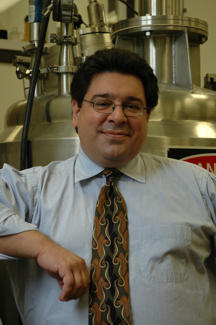
Cellulose Gums - Find Your Mixer
Welcome to our technical support forum…
"Ask Our Mixing Gurus"!
 Today's Topic: Cellulose gums
Today's Topic: Cellulose gums
Present by: George Nikolopoulos, Regional Sales Manager
Cellulose is the most abundant natural organic material on Earth. Most plants, especially trees, produce it as a structural material with long chains of simple glucose sugar molecules derived from photosynthesis. Cellulose, the principle component of wood, has many applications. In foods, it is indigestible and hard to chew.
With chemical modification, cellulose derivatives become very useful in foods, pharmaceuticals and many other familiar products. These derivatives are differentiated by the substitutions of various molecules along the polymer backbone. Perhaps the most useful and versatile derivatives are the methylcelluloses (MC):
|
CMC - SodiumCarboxyMethylCellulose HMC - HydroxyMethylCellulose |
And the hydroxyalkyl derivatives: HEC - HydroxyEthylCellulose
|
Cellulose gums are favored for their properties of Viscosity building, Film forming, Emulsion stabilization, Binding and Freeze-Thaw stabilizing. One unique property is gel formation at elevated temperatures. In contrast to most gels, MCs can form reversible gels at cooking temperatures that liquify as the product cools.
Food processors use CMC to thicken gravies, gums and sauces; stabilize oil/ water emulsions or stabilize gas bubbles in whipped toppings with its film forming and surfactant properties; as a non-caloric bulking agent and binder in prepared foods; and to prevent ice crystal growth in frozen foods. CMC is the active ingredient in fiber laxatives.
Pharmaceutical companies use MCs as binders, time release agents and inert fillers in tablets; as film coatings in capsules; and thickeners in syrups.
One challenge with cellulose gums is rapid dispersal in aqueous systems. The powder hydrates to form lumps that swell and stick to processing equipment or to form smaller clumps in water, commonly referred to as "fisheyes". While these eventually disperse, various strategies have been developed to avoid waiting for hours.
Admix recommends using a high shear mixer like our Rotosolveror Rotostat dispersers. These mixers make quick, smooth solutions of gums in minutes rather than hours, saving time, tanks, space and money for processors. Having problems with aeration? VacuShear could be the answer.
Bring us your mixing challenges, and we will recommend creative solutions...Please contact our application engineers at 800.466.2369 or email us at